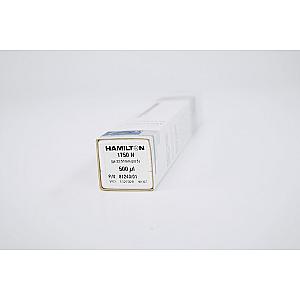The Hamilton Medical 81243 syringe is a precision syringe from the 1700 series, designed to provide a perfect seal when handling gases. With a volume of 500 µL, a cemented needle Luer tip (LTN) and a high-quality design made of borosilicate glass and PTFE, it guarantees reliable performance for the most demanding laboratory applications. Thanks to its robust design and conical side port, it is ideal for the precise dosing of liquids or gases. This model is particularly popular in analyses requiring a high level of precision.
Gastight Syringe 81243 - Perfect Condition





Offer Details
Accessories :
Hamilton 1750 N 500uL 81243/01 ( GA 22/51mm/PST 5 ) Supelco 20708 SYR
Options :
4969
Description
The Hamilton Medical 81243 syringe: a precision tool for demanding applications
The Hamilton Medical 81243 syringe is part of the 1700 series, a range specifically developed to offer exceptional performance in gas handling. This series is renowned for its ability to maintain a perfect seal, even under relatively high pressure conditions. With a net volume of 500 µL, it meets the needs of laboratories performing precise dosing of small quantities of fluids, while ensuring excellent reproducibility.
The 81243 model stands out in particular for its Luer Tip connection with a cemented needle, ensuring a solid and reliable connection and minimising the risk of leakage or fluid loss. This 22-gauge needle is designed with a style 5 tip, i.e. a conical side opening that allows for more controlled dispensing, which is particularly useful for certain analytical or automated dosing techniques. Its length of 51 mm makes it compatible with many automated injection or sampling systems.
The internal construction of this syringe is another key factor in its reliability. The materials used for the fluid path – stainless steel (SST), borosilicate glass and PTFE – guarantee maximum chemical inertness, reducing the risk of cross-contamination or reaction with the substances being handled. Although not autoclavable, this syringe can be sterilised by gas, making it suitable for environments requiring a high level of sterility.
In addition, the syringe body is designed with an internal diameter of 3.26 mm and an external diameter of 7.75 mm, ensuring a good grip and precise control of the piston. The maximum pressure supported by the device is 700 psig (48.3 bar), making it suitable for use in more demanding pressure conditions than standard syringes. Its operating temperature range is 10°C to 50°C, allowing for stable use in most laboratory environments.
The Hamilton Medical 81243 syringe is the preferred choice for laboratories seeking precision, reliability and compatibility with automated or manual dosing systems. Its careful design and high-quality materials make it an indispensable tool in fields such as gas chromatography, environmental analysis, pharmaceutical research and industrial quality control.
Features
- Ideal for precision dosing up to 500 µL
- Optimal sealing for gas applications
- Secure Luer tip with cemented needle for increased stability
- Side-opening needle for directional flow control
- Chemically resistant materials
- Compatible with manual and automated dosing techniques
- High pressure range for use in demanding environments
- Robust design for long service life
- Disposable or long-life syringe depending on application
- Clear visibility of the piston for precise volume control
Technical Details
- Useful volume: 500 µL
- Syringe type: Gastight (gas-tight)
- Series: 1700
- Termination: Luer Tip with cemented needle (LTN)
- Needle type: Cemented
- Needle gauge: 22 gauge
- Tip style: Style 5 – Conical side port
- Needle length: 51 mm
- Fluid path materials: Stainless steel (SST), borosilicate glass, PTFE
- Sterilisation: Non-autoclavable, gas sterilisable
- Maximum pressure: 700 psig (48.3 bar)
- Operating temperature: 10 °C to 50 °C
- Inner cylinder diameter: 3.26 mm
- Outer cylinder diameter: 7.75 mm
- Needle inner diameter: 0.41 mm
- Outer diameter of the needle: 0.72 mm
- Standard dead volume of the needle: 6.81 µL
Compatible Accessories
- Replacement needles (equivalent or customised models)
- Luer adapters for connection to other devices
- Syringe holders for automated systems
- Cleaning kits for piston and body maintenance
- Protective caps for sterile storage
- Rigid transport cases for on-site sampling
- Manual or automated filling stations